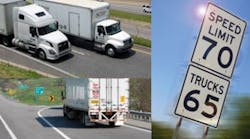The Dept. of Transportation has been planning a heavy truck speed limiter proposal for some time, and meanwhile, speed limiters will be one of the technologies truck makers can tap regarding fuel efficiency under the forthcoming Greenhouse Gas (GHG) Phase 2 rule. But as those regs are hashed out, fleets may not always see eye-to-eye with the federal agencies involved when it comes to GHG Phase 2 tech.
Speed limiters are one example of that, according to Michael Roeth, executive vice president of the North American Council for Freight Efficiency (NACFE). EPA would like to see permanent, unalterable limiters in place the whole life of the truck, he says, but fleets may want more flexibility.
"If you think about speed in a heavy truck, it's a big factor," Roeth notes. "The difference between running a truck at 60 mph and 70 mph is almost 1 mpg — and with fuel around $3.00/gal, 1 mpg for a Class 8 sleeper tractor can mean up to $10,000 a year in fuel costs."
So where's the difference of opinion? It may be a resale issue. "Fleets might never want to drive faster than 62 mph, but they don't want to buy a truck with a permanent 62-mph speed limiter because when they try to sell the truck in the used market, buyers often want to be able to set the top speed where they want it — and a lot of times, that means faster," he tells Fleet Owner.
At any rate, speed limiters are part of EPA's Greenhouse Gas Emissions Model, or GEM, compliance simulation app for the not-yet-finalized GHG Phase 2 rule. The software models vehicles from Classes 2b through 8 with specific subcategories and accompanying technology options, essentially calculating fuel efficiency and emissions rates.
Fuel savings and safety
If you talk to the folks at fleet leasing and business analytics firm Fleet Advantage, they'll tell you they're all for speed limiters for heavy trucks. Stephen Katona, the company's director of purchasing, recalls putting in speed limiters while at a former job managing the logistics division fleet of a major truck rental company.
"We ran 10,000 tractors and trailers. When we hit a spike in fuel and diesel hit $4.00/gal., that's when we started limiting the speed on all of our trucks," he says. "We did it primarily to save fuel back then, but what we noticed was we got safety benefits above and beyond that.
"Absolutely it works, from an environmental and fuel savings perspective," Katona continued. "From that point on, with every truck, we limited the speed." Just putting in speed limiters won't necessarily make a fleet safe, he notes,"but every little thing you do toward safety can help you."
Meanwhile, Terry Clouser, vice president of fleet services at Fleet Advantage, points out that it can also pay to incentivize drivers to use their cruise control. With truck speed limiters, "we encourage companies to go with a 2 mph difference in their foot pedal and their cruise control, so if they [drivers] go into cruise control, they get that extra 2 mph difference," he tells Fleet Owner.
"That also lets the computer control the throttle, which controls the fuel to the engine. It's just like autopilot on a plane; it's monitoring many times a second," Clouser explains. "So now the driver can focus more on his driving, watching for cars and road conditions at that moment. There's a safety incentive and there's an economic incentive."
Counterpoint
Not everyone supports speed limiters for heavy trucks or believes they'll improve safety. The Owner-Operator Independent Drivers Assn. (OOIDA), for its take, contends just the opposite: that it's dangerous to have different speed limits for trucks and everyone else.
"When cars and trucks operate at different speeds on the highway there is a significant negative impact on safety," the group wrote in a letter to Dept. of Transportation agencies working on the speed limiter proposal. OOIDA emphasizes its view that "the speed limit ought to be the same limit for all vehicles in order to foster a predictable, safer highway driving environment."



